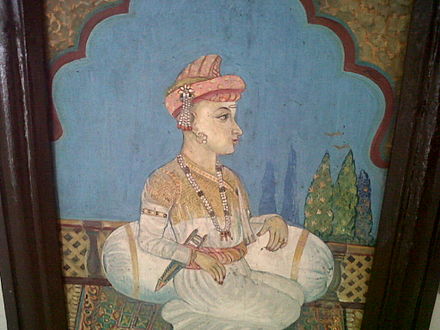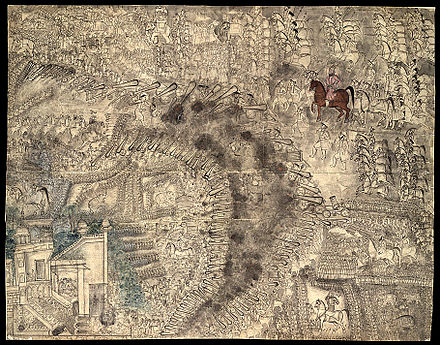Vishwasrao
Vishwasrao | |
|---|---|
 Portrait of Vishwasrao Bhat at Peshwa memorial, Pune | |
| Monarch | Rajaram II |
| Prime Minister | Balaji Baji Rao |
| Leader | Sadashivrao Bhau |
| In office 1751 – 14 January 1761 | |
| Personal details | |
| Born | 22 July 1742 Shaniwarwada, Pune, Maratha Empire |
| Died | 14 January 1761 (aged 18) Panipat, Maratha Empire |
| Spouse | Lakshmibai (maiden name: Durgabai Dikshit-Patwardhan) |
| Relations | Madhavrao I (brother) Narayan Rao (brother) Sadashivrao Bhau (uncle) Raghunathrao (uncle) Shamsher Bahadur I (uncle) Baji Rao I (grandfather) Kashibai (grandmother) |
| Parent(s) | Balaji Baji Rao (father) Gopikabai (mother) |
| Residence(s) | Shaniwar wada, Poona |
| Military service | |
| Allegiance | |
| Battles/wars | |
Vishwasrao Bhat (22 July 1742 – 14 January 1761) was the eldest son and heir of Peshwa Balaji Baji Rao of the Maratha Empire. From early in his life, he was trained in administrative matters and exposed to military training. He was killed during the Third Battle of Panipat.
Early life

Vishwasrao was born at Supe, the Jagir of Shahaji, near Pune. He is said to have inherited the appearance of his grandfather Baji Rao I, but had blue eyes. Historian Govind Sakharam Sardesai wrote that there was none as fine looking in Peshwa lineage as Vishwasrao. Raghunath Yadav, author of one of the Panipat Bakhar, stated, "पुरुषात देखणा विश्वासराव" ("The one most handsome among all men [was] Vishwasrao").[1][2]
Vishwasrao received training in administration and warfare from the age of 8 years. He impressed the Maratha infantry as a skilled swordsman and archer. Writer Kaustubh Kasture states in his book Sakalraj Karya Dhurandar Sadashivrao Bhausaheb that Sadashivrao Bhau, his paternal uncle, made sure that Vishwasrao took military training. According to some sources, Nanasaheb Peshwa introduced regular army training and added the best armour to the Maratha army.[3]
Vishwasrao married Lakshmibai, the daughter of Hari Balkrushn Dikshit-Patwardhan, on 2 May 1750.[2][4]
He then fought a series of militant campaigns to reduce Mughal rule in India, after several battles Vishwasrao was able to conspire the assassination of the Mughal emperor Alamgir II, after which he attempted to place himself upon the throne in Delhi.

Death
Vishwasrao was first exposed to actual warfare in a battle at Sindkheda against the Nizam of Hyderabad in 1756. During the Battle of Udgir, Shrimant Vishwasrao established himself as a valorous Maratha leader.[citation needed]
He was the nominal Commander of Maratha Forces and the Peshwa's representative during the Third Battle of Panipat (1761) under the guidance and leadership of his uncle Sadashivrao Bhau.[6] At the time of the battle, the Maratha Empire controlled about two-thirds of the Indian subcontinent (including areas of the modern Republic of India and Pakistan).
On the final day of the battle, during the period of the most intense fighting (approximately 01:00–02:30 PM), Vishwasrao was first hit by an arrow which injured his shoulder and then shot in his head while lying down[7][8] by a bullet fired by a Pashtun officer[note 1] and died fighting on the front lines. As per British historian Grant Duff, upon hearing about Shrimant Vishwasrao's death, Malharrao Holkar retreated from the field with at least 10,000 soldiers and sardars, taking men of significance like Damaji Gaekwad with him. He went to Delhi and asked people of significance to vacate the city.[citation needed]
In popular culture
- In the 1994 Hindi TV series The Great Maratha, Vishwasrao's character was portrayed by Sanjay Sharma.
- In the 2019 film Panipat, Vishwasrao's character was portrayed by Abhishek Nigam.[9]
- In the 2019 Marathi TV series Swamini, Vishwasrao's character was portrayed by Sujit Deshpande.
Notes
- ^ Citing contemporary Afghan sources, Lal states that the officer in question was probably one Bahadar Khan Tarin.[8]
See also
References
- ^ Abhas Verma, "Third Battle of Panipat", Bhartiya Kala Prakashan, ISBN 9788180903397
- ^ a b Sharma, Priyanka (10 May 2021). "Vishwasrao Peshwa". History Flame. Retrieved 10 November 2023.
- ^ "विश्वासराव पेशवे". 7 September 2023.
- ^ Kasture, Kaustubha; कस्तुरे, कौस्तुभ. Peśavāī : Mahārāshṭrācyā itihāsātīla eka suvarṇapāna. Mumbaī. ISBN 978-81-922379-8-5. OCLC 948661274.
- ^ S. M. Ikram (1964). "XIX. A Century of Political Decline: 1707–1803". In Ainslie T. Embree. Muslim Civilization in India. New York: Columbia University Press. Retrieved 5 November 2011.
- ^ Chandra, Bipan (2020). History of Modern India. Orient BlackSwan. ISBN 978-93-90122-55-4.
- ^ Rai, Kasi (1926). Rawlinson, H. G. (ed.). An Account of the Last Battle of Panipat: And of the Events Leading to it. Translated by Brown, James. Oxford University Press.
- ^ a b Lal, D. R. (1932). Third Battle of Panipat - A Historical Account. Lahore: FC College Press. p. 174.
- ^ https://www.imdb.com/title/tt8176040/fullcredits [unreliable source?]
External links
- https://mafiadoc.com/hindu-pad-padashahi_5a1cac031723dd4f437b5e76.html
- http://www.smartyoungsters.com/2019/09/mee-radhika-book-3the-starry-night-at.html?